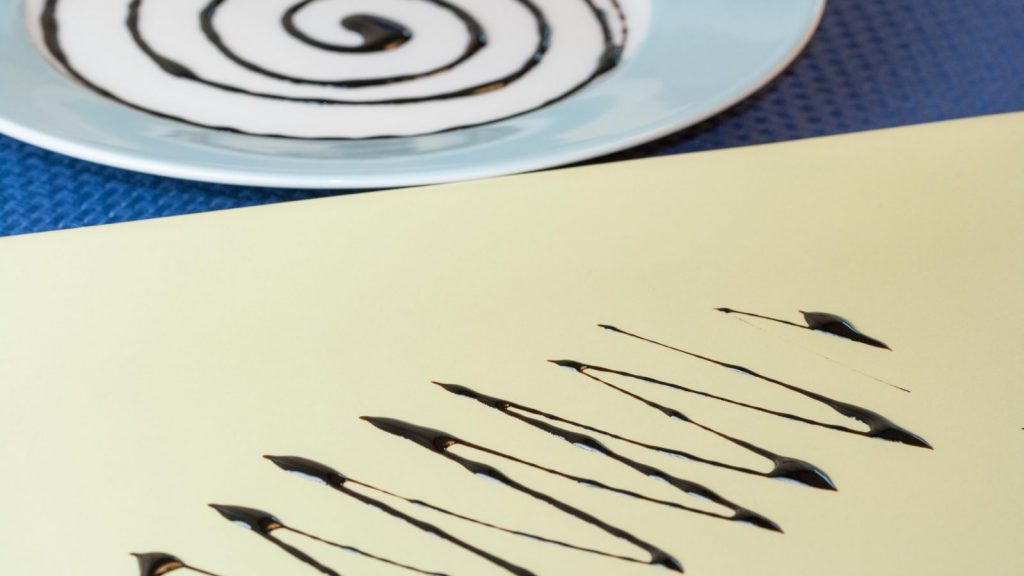Balsamic Vinegar Reduction
This easy-to-make balsamic vinegar reduction adds a fancy finishing touch to appetizers like Salmon Tartare, Crab Cakes, or Tomato Salad. The vinegar is reduced into a glaze, and it stays fresh in the refrigerator indefinitely.
Calories: 15kcal
Ingredients
- 1 cup balsamic vinegar
Instructions
Please! Do not use expensive balsamic vinegar to make the reduction; it will be a big waste of a fantastic product and money. Use an inexpensive imitation of the real balsamic vinegar of Modena.
- Pour vinegar into a small stainless steel saucepan. Bring to a boil and reduce on medium heat to ¼ cup, or until the vinegar turns to a glaze.
- Leave at room temperature for a few minutes to slightly cool before pouring in a plastic squeeze bottle. Now, keep in the refrigerator.
- Before use, set the squeeze bottle of reduced vinegar out until it reaches room temperature.
- To decorate, drizzle the balsamic vinegar reduction around the plated food or over the plate.
Video
Notes
History of balsamic vinegar:
- Balsamic vinegar can only be produced in the regions of Modena and Reggio in Italy. The first historical reference to balsamic vinegar dates back to 1046 when a bottle of balsamic vinegar was reportedly given to Emperor Enrico III of Franconia as a gift. In the Middle Ages, it was used as a disinfectant. Balsamic vinegar also had a reputation as a miracle cure, good for everything from sore throats to labor pains.
- Made from the white Trebbiano grape, balsamic vinegar gets its pungent sweetness from aging for several years in wood barrels. During the Middle Ages, this sugar-rich grape was used primarily for wine, but its high acidity made it better suited for producing vinegar. Produced in Modena, Italy, the maturation process takes place in a series of barrels made from a variety of woods and lasts from 6 to 25 years.
Cooking Tips for Balsamic Vinegar Reduction:
- Monitor the Heat: Keep the heat on medium to avoid burning the vinegar, which could impart a bitter flavor. Stir occasionally to ensure the vinegar reduces evenly.
- Adjust Consistency: If the reduction becomes too thick after cooling, reheat gently and add a splash of water to thin it to your desired consistency.
- Perfect for Marinades: Use the balsamic reduction as a marinade for meats like chicken, pork, or steak. Add olive oil and garlic for extra depth of flavor.
- Pairs Well with Cheese: Drizzle over fresh cheeses like goat cheese or mozzarella for a sophisticated appetizer.
- Add Sweetness: Enhance the balsamic reduction by combining it with fruit, such as figs or berries, for a sweet-savory sauce that complements grilled meats.
- Try It with Desserts: The balsamic reduction also works well as a topping for fruit-based desserts, like sorbet or panna cotta, balancing sweetness with tangy depth.
Elevate Your Culinary Skills with Online Culinary School!
Ready to elevate your cooking skills? Join us today to explore a range of culinary courses designed for every skill level! Whether you’re a beginner or looking to master advanced techniques, our hands-on courses make learning to cook both enjoyable and rewarding. 🍲👩🍳👨🍳
🔥 Craving some delicious salmon recipes? Check out our curated selection here: Salmon Recipes
🎥 Subscribe to our YouTube channel for more culinary inspiration and tutorials.
➡️ Start your culinary journey today: Learn to cook with us!
